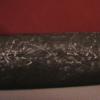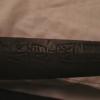Hello all, |
|||
 |
Nihonto ClubJapanese Sword Information Exchange |
User login |
|
|
Disclaimer: Nihontō Club owners and independent contributors will not be held responsible for any loss, damage or inconvenience caused as a result of any inaccuracy or error within this website. Except where otherwise noted, this page is licensed under a Creative Commons License.
|





.
The first one is a date: 1942.
The second is the smith's name, but I may need help from wife.
The third is painted-on stuff, generally military numbers of some sort (not interesting/important AFAIK).
The fourth is clearly on older blade. The signature is Fujiwara Kuniyuki. One possibility dates from the mid-1600's. I did not attempt to compare the signature against any reference books...
Pete
Thanks again Pete, i will
Thanks again Pete,
i will make a point of doing better images over the weekend,any suggestions on books or sites to get to look such things up?
Peter
.
This site is one resource.
Another is www.jssus.org .
Pete
Thank you Pete, will try to
Thank you Pete,
will try to load what pic i have to see how you and the wife do with them, is it advisory to try and clean stuba and fitting, ie have a naval sword with solid stuba,
Peter
.
My advice on cleaning:
For WWII fittings, it is generally OK to use an old toothbrush and baking soda with a bit of water. Nothing more harsh than that. I'm assuming that there's no lacquer or delicate finishes to worry about.
I do not advise 'cleaning' wood parts, or handle-wrappings, etc., other than wiping off obvious 'dirt' with a cloth.
A WWII blade can be wiped down with a soft cotton cloth and a few drops of good-quality gun oil. Cotton flannel (white - bought at a fabric store) is good.
On the tang, just rub *gently* with a soft, dry cloth (no oil or anything else). It is OK to handle the tang with bare hands. Avoid touching the blade with anything other than a soft clean cloth. Salt and oils from your skin will lead to rust stains that become permanent.
If the inside of the saya (scabbard) is dirty, don't put the blade back into it (there is generally no easy way to clean the inside of a saya).
Pete
Hidetoshi
The second picture (signature) is Hidetoshi.
The smith could possibly be HID195, as listed in Hawley, or in ToShoW, or in the database on this site.
Pete
uchiko, choji, and washi
Another note on blade-cleaning, as it relates to old, good-quality, blades and such:
The traditional way to clean a blade involves using uchiko, choji, and washi. Look on the web for info about the technique.
Uchiko is a very fine abrasive stone powder.
Washi is traditional hand-made paper (often incorrectly called "rice paper").
Choji is clove oil.
Uchiko is still recommended, if used correctly.
Instead of washi (which is expensive), I prefer plain white cotton flannel, cut into roughly 2" squares. Use white so that you can tell when there is something on it (dirt), and to avoid dyes and such. Avoid cheap papers, such as Kleenex-type tissues (think about it - the stuff is the cheapest type of paper known to man, suitable for blowing your nose into...). However, I know of an advanced collector who used Kleenex all the time on high-quality blades.
Choji oil today is questionable. I live in a dry climate, so I don't use oil on a 'good' blade at all. The little bottles of "choji oil" sold today are very likely a modern oil with a clove scent added (so that it smells right). I avoid using the stuff, because they don't tell you what's really in it. Years ago, somebody did some chemical analysis on the stuff, and the result was essentially automatic transmission fluid... If I have to use oil at all, I use good-quality gun oil, such as "CLP Break-Free".
DO NOT use "clove oil" bought at the grocery store - who knows what has been added to it.
DO NOT use "motor oil", or cheap oil such as "3-in-one" or "WD40". Some oils become gummy with age, and some can attract moisture from the air (worse than no oil at all).
I figure that an oil that is made for very expensive firearms is a good way to go, because the requirements are the same: It is for use on hi-quality carbon steels (must not promote rust in any way), it must not become gummy, and it must not attract moisture. But do NOT use a gun oil (or powder solvent) that contains any special 'cleaning' or 'restoring' chemicals, because there is a risk of staining the steel.
This is my opinion; your mileage may vary.
Pete
Thanks Pete, Good read. was
Thanks Pete,
Good read. was going to use my shotgun oil when got my 1st blade but didn,t, i got some choji oil, but now i know what to look out for in oils, not sure what the ref:HID 195 is? i,m not great around a computer . if i could pick ur brain again if i,m not being a pain, i want a nice old hand made blade and not so sure about ebay, any suggestions?
again thank you,
Peter
HID195
As for HID195: On this site's home page, click on "Swordsmith Index". In the blank box under "Name / Starts with" enter Hidetoshi, then click the "Apply" button.
You'll see 4 smiths named "Hidetoshi". The first one (HID195) is the only one that has the correct name-kanji (and the correct time period).
As for buying a blade on eBay: It's risky, unless you know for certain that you can trust the seller 100%. Even then, you still have to know how much to bid.
Do you live near a major city? My advice is to get in touch with other collectors, go to their club meetings (or whatever), and spend some time learning the basics "hands-on". There will always be some folks that are willing to help you, and not take advantage of you (and there are some folks that are the opposite). There's no substitute for holding a blade in your hand, and having a veteran point out stuff like: "See this? This is a serious problem with this blade.".
Pete
Re: HID195
Hi Pete,
I've created a link to Hidetoshi HID195 in your original comment for your and others convenience.
Regards,
Stan
P.S. The topic has been moved into a more appropriate section of the discussion forum.
Thank you Stan, that helps a
Thank you Stan,
that helps a lot with id the sword, how does the rating system work? ie 8,
Peter
rating
Re: The Hawley ratings (one of my favorite subject to rant about ;-) ).
The data in several of the most popular online swordsmith lists is based on the book "Japanese Swordsmiths" by Hawley. He was an American who compiled the first large swordsmith list in English. His list was based on various Japanese references such as "Nihonto Meikan" and others. Hawley's book does not contain 'new information' - everything in it can be found in the classic Japanese texts.
Hawley assigned a number rating to each smith, with 400 being the highest. I don't think anyone knows exactly how he chose the numbers. It might have been based on things like how much a certain smith is discussed in a certain famous book, etc. Perhaps something like a half-page in Fujishiro gets a 20, while a full page gets a 40...
In my opinion, the Hawley rating has very limited value, since he didn't explain the numbering system, and because he clearly gave unreasonably low/high ratings to certain smiths.
For example, he gave "8" (the lowest rating) to all (or nearly all) 20th-century smiths.
A smith with a number of 20 is most certainly NOT twice as good (or twice as valuable) as a smith with a 10.
There are some veteran collectors (outside of Japan) who give a lot of weight to the Hawley ranking, but I disagree.
Also, a rating based on a smith (rather than a specific blade) doesn't take into account the condition of a blade, or how consistently a given smith could make a really fine blade, etc.
My advice is to focus on what make a particular blade good or bad, and don't worry about the reputation of the smith.
The smith reference numbers (such as HID195) were also assigned by Hawley. They are a de-facto system for identifying a smith (outside of Japan). Amongst Japanese collectors (and some Western collectors) a smith is identified by things like his name, school, and time period.
Pete
Re: rating
Hi Pete,
I would totally agree with your description of Hawley ratings. I personally almost never use them to judge a sword or a smith. But I find Hawley ratings useful when looking for a particular smith. As higher profile smiths would most likely have a higher rating (e.g. when looking for the smith record by name and province) and vice versa.
Regards,
Stan